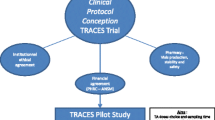Abstract
Introduction
Anti-fibrinolytic agents are used to reduce obstetric blood loss as the fibrinolytic system is known to get activated after placental delivery.
Objectives
To evaluate the efficacy of parenteral tranexamic acid in reducing blood loss during normal labour and to compare it with the amount of blood loss in patients who received placebo in the third stage of labour.
Methodology
Patients with spontaneous labour or planned for induction of labour and fulfilling the inclusion criteria were recruited for the study. In each patient, the pre-delivery pulse rate, blood pressure, Hb gm% and PCV% were noted. Labour was monitored carefully using a partogram. The study group received Inj. Oxytocin and Inj. Tranexamic acid. The control group received Inj. Oxytocin and Placebo injection. Immediately after delivery of the baby, when all the liquor was drained, the patient was placed over a blood drape—a disposable conical, graduated plastic collection bag. The amount of blood collected in the blood drape was measured. Then the patient was given pre-weighed pads, which were weighed 2 h post-partum. The blood loss was measured by measuring the blood collected in the drape and by weighing the swabs before and after delivery.
Results
The total number of patients studied was 100—equally distributed in both the groups. The age group of the patients and BMI were comparable. There was a significant increase in the pulse rate and decrease in blood pressure in the control group as compared with the study group. The post-delivery haemoglobin and haematocrit were significantly reduced in the control group as compared to the study group. The mean blood loss at the end of 2 h was 105 ml in the study group and 252 ml in the control group. There was a significant increase in the usage of uterotonics and also in the need for blood transfusion in the control group; 12 % of the patients in the control group had to stay for more than 3 days compared to 2 % in the study group.
Conclusion
Tranexamic acid injection, an antifibrinolytic agent when given prophylactically after the delivery of the baby, by intravenous route appears to reduce the blood loss and maternal morbidity during normal labour effectively.
Similar content being viewed by others
References
Henry DA, Carless PA, Moxey AJ et al. Antifibrinolytic use for minimizing perioperative allogenic blood transfusion. Cochrane Database Syst Rev. 2007; Issue 4. Art No: CD001886.
Lethaby A, Farquhar C. Antifibrinolytics for heavy menstrual bleeding. Cochrane Database Syst Rev. 2000; Issue 4. Art No: CD000249.
Mac Mullen NJ, Dulski LA, Meagher B. MCN Am J. 2005;30:40–51.
Gai MY, Wu LF, Su QF, et al. Clinical observation of blood loss reduced by tranexamic acid during and after caesarean section: a multi center randomized trial. Eur J Obstet Gynaecol Reprod Biol. 2004;112(2):154–7.
Pattinson RC. Saving mothers—third report on confidential enquiries into maternal deaths in South Africa 2002–04 Pretoria, S.Africa. Pretoria: Department of Health; 2006.
As AK, Hagen P, Webb JB. Tranexamic acid in management of PPH. Br J Obstet Gynaecol. 1996;103(12):1250–1.
Yang H, Zheng S, Shi C. Clinical study on the efficiency of tranexamic acid in reducing postpartum blood loss—a randomized multicentre trial. Zhonghua Fu Chan Zazhi. 2001;36(10):590–2.
Peitsidis P, Kadir RA. Tranexamic acid in pregnancy and postpartum. Expert Opin Pharmacother. 2011;12(4):503–16.
Leduc D, Senikas V. Active management of third stage of labour: prevention and treatment of PPH. J Obstet Gynaecol Can. 2009;31(10):980–93.
Novikova N, Hofmeyr GJ. Tranexamic acid for preventing postpartum haemorrhage. Cochrane Database Syst Rev. 2010;(7):CD007872.
Soltani H, Hutchon DR. Timing of prophylactic uterotonics for third stage of labour after vaginal birth. Cochrane Database Syst Rev. 2010; 4(8): CD006173.
Tesseir V, Pierre F. Risk of PPH during labour and clinical and pharmacological prevention. J Obstet Gynaecol. 2004;33:4529–56.
Sekhavat L, Tabatabaii A. Efficacy of tranexamic acid in reducing blood loss after caesarean section. J Matern Fetal Neonatal Med. 2009;22(1):72–5.
Litch JA. Program for appropriate technology and health. Seattle: AMTSL; 2004. p. 132.
Gokhan. Routine practice of using tranexamic acid in AMTSL. NCT01338454, Bakirkoy; 2011.
La Londe A, Daviss BA. PPH today: ICM/FIGO initiative 2004–2006. Int J Obstet Gynaecol. 2006;94:243–53.
Astedt B. Clinical pharmacology of tranexamic acid. Scand J Gastroenterol. 1987;137:22–5.
Author information
Authors and Affiliations
Corresponding author
Ethics declarations
Conflict of interest
There is no conflict of interest involved within the authors of the study.
Ethical Statement
Ethical clearance was obtained from the ethical committee. This study was self-funded and no grants were received in the form of sponsorship.
Informed Consent
Written informed consent has been obtained from all the patients before they were enrolled into the study.
Additional information
Dr. Priyankur Roy is postgraduate student in the Department of Obstetrics and Gynaecology at JSS Medical College and Hospital; Dr. M. S. Sujatha is Professor and Head of the Unit in the Department of OBG Unit II at JSS Medical College and Hospital; Dr. Ambarisha Bhandiwad is Professor and Head of the Department in the Department of OBG, JSS Medical College and Hospital, at JSS University; Dr. Bivas Biswas is Senior Clinical Fellow in the Department of Obstetrics and Gynaecology at King’s Mill Hospital.
Rights and permissions
About this article
Cite this article
Roy, P., Sujatha, M.S., Bhandiwad, A. et al. Role of Tranexamic Acid in Reducing Blood Loss in Vaginal Delivery. J Obstet Gynecol India 66 (Suppl 1), 246–250 (2016). https://doi.org/10.1007/s13224-016-0856-4
Received:
Accepted:
Published:
Issue Date:
DOI: https://doi.org/10.1007/s13224-016-0856-4




